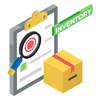Unlock the power of inventory management software for your businesses
Discover how inventory management solutions can help you save time and increase efficiency.
Powerful business solutions through innovation
User-friendly, easy-to-use interfaces
Focused, industry-specific tech solutions
Managing inventory effectively is critical to ensure the smooth operation of retail businesses. The right inventory management software allows businesses to track stock levels, streamline ordering processes, and reduce human error. By integrating these systems, businesses can automate tasks, save valuable time, and optimise their operations.
Wholesale businesses often face the challenge of maintaining accurate stock records, which can lead to overstocking, stockouts, or lost sales opportunities. Inventory management solutions address these issues, providing real-time insights into stock levels and helping businesses make informed decisions.
With the evolution of technology, inventory management systems such as wholesale EPOS systems have become more affordable and accessible to small businesses. These cloud-based solutions, for instance, allow businesses to manage their inventory remotely, ensuring they always have up-to-date information and complete visibility of their stock.

How have wholesale EPOS systems revolutionised inventory management software?
Wholesale EPOS systems have transformed inventory management by offering real-time tracking, precise data insights, and seamless integration with stock management software. These systems automate inventory processes, reduce errors, and provide retailers and wholesalers with powerful tools for demand forecasting and stock optimisation, enhancing overall business efficiency and improving customer satisfaction.

Enhanced accuracy in stock tracking
Inventory management solutions automate stock tracking, reduce human error and ensure real-time updates of stock levels through barcodes or RFID. This accuracy helps avoid overstocking and understocking, maintain optimal stock levels aligned with demand and improve cash flow.

Improved order management and fulfilment
By automatically updating stock levels, inventory software streamlines order management. It prevents stockouts and enables quick order fulfilment. Additionally, automatic reorder points trigger new orders when stocks reach a set level, ensuring consistent product availability for customers.

Cost reduction and better resource allocation
These systems help reduce operational costs by maintaining leaner stock levels. It forecasts demand, cuts unnecessary purchases, and prevents overstocking, allowing businesses to optimise resources and avoid waste. It also provides insights to improve cost-effective stock management.

Better decision-making with data insights
With detailed data insights on sales and stock trends, inventory software enables businesses to predict demand and optimise stock levels. It also helps identify slow-moving products, allowing businesses to make informed decisions on promotions, discounts, and product discontinuation.
How do EPOS systems enhance your business operations?
EPOS systems are an essential tool for modern small businesses, combining sales tracking with inventory management capabilities. Here are six reasons why EPOS systems can enhance your business operations:
1. Real-time stock updates
EPOS systems provide instant updates on stock levels after each sale, ensuring that businesses have accurate, up-to-date inventory information.
2. Automated reorder alerts
EPOS systems can trigger automatic reorder alerts when stocks reach a predefined threshold, ensuring businesses never run out of critical inventory.
3. Improved customer experience
By streamlining the checkout process and ensuring faster transactions, EPOS systems improve the customer experience, increasing satisfaction and loyalty.
4.Centralised sales data
EPOS systems consolidate sales data in real-time, offering businesses insights into purchasing trends, customer preferences, and sales performance.
5. Cost-effective integration
EPOS systems are designed to integrate with existing business software like accounting and CRM systems, reducing the need for multiple software systems.
6. Simplified reporting
EPOS systems generate detailed reports that help businesses analyse sales, stock levels, and trends, providing valuable insights for decision-making.
Elevate your business with revolutionary inventory management solutions
Implementing EPOS systems to change the way your businesses manage stock and improve overall operations by automating processes, reducing errors, and providing valuable insights.
Ready to optimise your inventory and improve efficiency? Start exploring WITMEG inventory management software today and experience the difference it can make for your business.
Key Features of WITMEG to add value to businesses
Are you ready to give the biggest boost possible for your business?
Technical Support
24/7 technical support dedicated to an exceptional customer service
Cloud Sync
Real-time data syncing to the Cloud when connected to an active internet connection
Offline Access
Fully functional system even when there is no internet connection available
FAQs
The best software for tracking inventory depends on the specific needs of your business. Popular options include EPOS systems like WITMEG. These platforms offer features like real-time tracking, reporting, and seamless integration with POS systems.
The four main types of inventory management systems are:
Periodic Inventory System
Perpetual Inventory System
Just-in-Time (JIT) Inventory
FIFO (First-In-First-Out)
Each system has its strengths depending on the nature of the business and its inventory needs.
wholesale EPOS systems reduce the risk of stockouts by providing real-time visibility into stock levels and automatically tracking inventory movements and sales. Many systems also feature automated reorder points, where alerts or new orders are generated once stocks reach a certain level. By forecasting demand based on historical data, inventory software ensures businesses maintain optimal stock levels, preventing the loss of sales due to unavailable items and improving overall customer satisfaction.
